Lei Feng
Neural Network Reprogrammability: A Unified Theme on Model Reprogramming, Prompt Tuning, and Prompt Instruction
Jun 05, 2025Abstract:As large-scale pre-trained foundation models continue to expand in size and capability, efficiently adapting them to specific downstream tasks has become increasingly critical. Despite substantial progress, existing adaptation approaches have evolved largely in isolation, without a clear understanding of their interrelationships. This survey introduces neural network reprogrammability as a unifying framework that bridges mainstream model adaptation techniques--model reprogramming, prompt tuning, and prompt instruction--previously fragmented research areas yet converges on a shared principle: repurposing a pre-trained model by manipulating information at the interfaces while keeping the model parameters frozen. These methods exploit neural networks' sensitivity to manipulation on different interfaces, be it through perturbing inputs, inserting tokens into intermediate layers, or providing task-specific examples in context, to redirect model behaviors towards desired outcomes. We then present a taxonomy that categorizes such information manipulation-based adaptation approaches across four key dimensions: manipulation format (fixed or learnable), location (interfaces where manipulations occur), operator (how they are applied), and output alignment requirement (post-processing needed to align outputs with downstream tasks). Notably, this framework applies consistently across data modalities, independent of specific model architectures. Moreover, viewing established techniques like in-context learning and chain-of-thought prompting through this lens reveals both their theoretical connections and practical distinctions. We further analyze remaining technical challenges and ethical considerations, positioning neural network reprogrammability as a fundamental paradigm for efficient model adaptation. We lastly identify promising research directions emerging from this integrative viewpoint.
GUARD: Generation-time LLM Unlearning via Adaptive Restriction and Detection
May 19, 2025Abstract:Large Language Models (LLMs) have demonstrated strong capabilities in memorizing vast amounts of knowledge across diverse domains. However, the ability to selectively forget specific knowledge is critical for ensuring the safety and compliance of deployed models. Existing unlearning efforts typically fine-tune the model with resources such as forget data, retain data, and a calibration model. These additional gradient steps blur the decision boundary between forget and retain knowledge, making unlearning often at the expense of overall performance. To avoid the negative impact of fine-tuning, it would be better to unlearn solely at inference time by safely guarding the model against generating responses related to the forget target, without destroying the fluency of text generation. In this work, we propose Generation-time Unlearning via Adaptive Restriction and Detection (GUARD), a framework that enables dynamic unlearning during LLM generation. Specifically, we first employ a prompt classifier to detect unlearning targets and extract the corresponding forbidden token. We then dynamically penalize and filter candidate tokens during generation using a combination of token matching and semantic matching, effectively preventing the model from leaking the forgotten content. Experimental results on copyright content unlearning tasks over the Harry Potter dataset and the MUSE benchmark, as well as entity unlearning tasks on the TOFU dataset, demonstrate that GUARD achieves strong forget quality across various tasks while causing almost no degradation to the LLM's general capabilities, striking an excellent trade-off between forgetting and utility.
The Final Layer Holds the Key: A Unified and Efficient GNN Calibration Framework
May 16, 2025Abstract:Graph Neural Networks (GNNs) have demonstrated remarkable effectiveness on graph-based tasks. However, their predictive confidence is often miscalibrated, typically exhibiting under-confidence, which harms the reliability of their decisions. Existing calibration methods for GNNs normally introduce additional calibration components, which fail to capture the intrinsic relationship between the model and the prediction confidence, resulting in limited theoretical guarantees and increased computational overhead. To address this issue, we propose a simple yet efficient graph calibration method. We establish a unified theoretical framework revealing that model confidence is jointly governed by class-centroid-level and node-level calibration at the final layer. Based on this insight, we theoretically show that reducing the weight decay of the final-layer parameters alleviates GNN under-confidence by acting on the class-centroid level, while node-level calibration acts as a finer-grained complement to class-centroid level calibration, which encourages each test node to be closer to its predicted class centroid at the final-layer representations. Extensive experiments validate the superiority of our method.
Establishing Linear Surrogate Regret Bounds for Convex Smooth Losses via Convolutional Fenchel-Young Losses
May 15, 2025Abstract:Surrogate regret bounds, also known as excess risk bounds, bridge the gap between the convergence rates of surrogate and target losses, with linear bounds favorable for their lossless regret transfer. While convex smooth surrogate losses are appealing in particular due to the efficient estimation and optimization, the existence of a trade-off between the smoothness and linear regret bound has been believed in the community. That being said, the better optimization and estimation properties of convex smooth surrogate losses may inevitably deteriorate after undergoing the regret transfer onto a target loss. We overcome this dilemma for arbitrary discrete target losses by constructing a convex smooth surrogate loss, which entails a linear surrogate regret bound composed with a tailored prediction link. The construction is based on Fenchel-Young losses generated by the convolutional negentropy, which are equivalent to the infimal convolution of a generalized negentropy and the target Bayes risk. Consequently, the infimal convolution enables us to derive a smooth loss while maintaining the surrogate regret bound linear. We additionally benefit from the infimal convolution to have a consistent estimator of the underlying class probability. Our results are overall a novel demonstration of how convex analysis penetrates into optimization and statistical efficiency in risk minimization.
A semantic communication-based workload-adjustable transceiver for wireless AI-generated content (AIGC) delivery
Mar 24, 2025Abstract:With the significant advances in generative AI (GAI) and the proliferation of mobile devices, providing high-quality AI-generated content (AIGC) services via wireless networks is becoming the future direction. However, the primary challenges of AIGC service delivery in wireless networks lie in unstable channels, limited bandwidth resources, and unevenly distributed computational resources. In this paper, we employ semantic communication (SemCom) in diffusion-based GAI models to propose a Resource-aware wOrkload-adjUstable TransceivEr (ROUTE) for AIGC delivery in dynamic wireless networks. Specifically, to relieve the communication resource bottleneck, SemCom is utilized to prioritize semantic information of the generated content. Then, to improve computational resource utilization in both edge and local and reduce AIGC semantic distortion in transmission, modified diffusion-based models are applied to adjust the computing workload and semantic density in cooperative content generation. Simulations verify the superiority of our proposed ROUTE in terms of latency and content quality compared to conventional AIGC approaches.
Uncertainty-Aware Normal-Guided Gaussian Splatting for Surface Reconstruction from Sparse Image Sequences
Mar 14, 2025Abstract:3D Gaussian Splatting (3DGS) has achieved impressive rendering performance in novel view synthesis. However, its efficacy diminishes considerably in sparse image sequences, where inherent data sparsity amplifies geometric uncertainty during optimization. This often leads to convergence at suboptimal local minima, resulting in noticeable structural artifacts in the reconstructed scenes.To mitigate these issues, we propose Uncertainty-aware Normal-Guided Gaussian Splatting (UNG-GS), a novel framework featuring an explicit Spatial Uncertainty Field (SUF) to quantify geometric uncertainty within the 3DGS pipeline. UNG-GS enables high-fidelity rendering and achieves high-precision reconstruction without relying on priors. Specifically, we first integrate Gaussian-based probabilistic modeling into the training of 3DGS to optimize the SUF, providing the model with adaptive error tolerance. An uncertainty-aware depth rendering strategy is then employed to weight depth contributions based on the SUF, effectively reducing noise while preserving fine details. Furthermore, an uncertainty-guided normal refinement method adjusts the influence of neighboring depth values in normal estimation, promoting robust results. Extensive experiments demonstrate that UNG-GS significantly outperforms state-of-the-art methods in both sparse and dense sequences. The code will be open-source.
Wireless Hallucination in Generative AI-enabled Communications: Concepts, Issues, and Solutions
Mar 08, 2025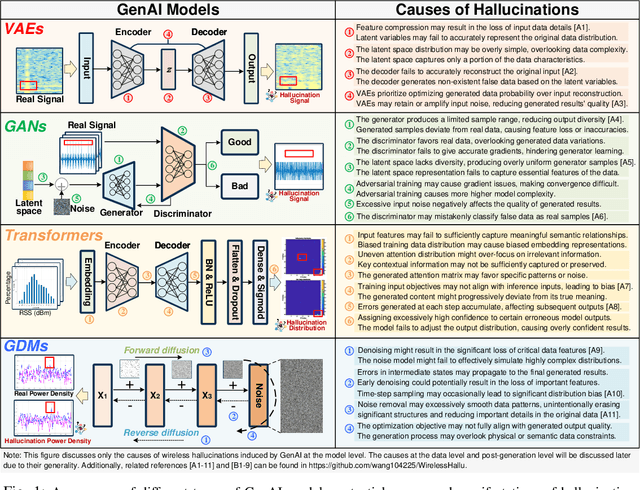
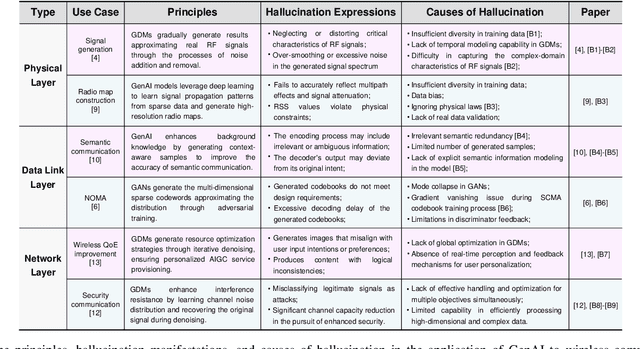
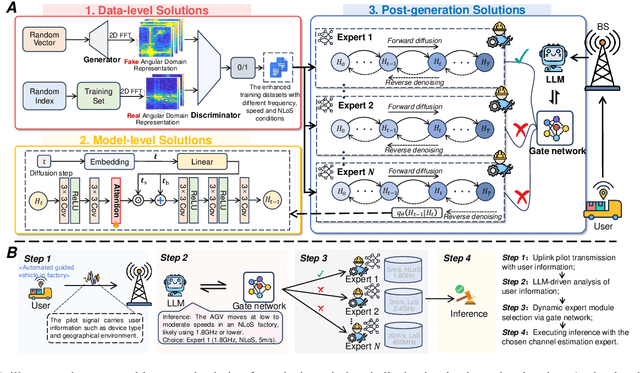

Abstract:Generative AI (GenAI) is driving the intelligence of wireless communications. Due to data limitations, random generation, and dynamic environments, GenAI may generate channel information or optimization strategies that violate physical laws or deviate from actual real-world requirements. We refer to this phenomenon as wireless hallucination, which results in invalid channel information, spectrum wastage, and low communication reliability but remains underexplored. To address this gap, this article provides a comprehensive concept of wireless hallucinations in GenAI-driven communications, focusing on hallucination mitigation. Specifically, we first introduce the fundamental, analyze its causes based on the GenAI workflow, and propose mitigation solutions at the data, model, and post-generation levels. Then, we systematically examines representative hallucination scenarios in GenAI-enabled communications and their corresponding solutions. Finally, we propose a novel integrated mitigation solution for GenAI-based channel estimation. At the data level, we establish a channel estimation hallucination dataset and employ generative adversarial networks (GANs)-based data augmentation. Additionally, we incorporate attention mechanisms and large language models (LLMs) to enhance both training and inference performance. Experimental results demonstrate that the proposed hybrid solutions reduce the normalized mean square error (NMSE) by 0.19, effectively reducing wireless hallucinations.
LanP: Rethinking the Impact of Language Priors in Large Vision-Language Models
Feb 17, 2025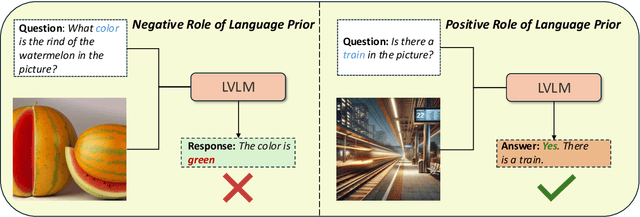
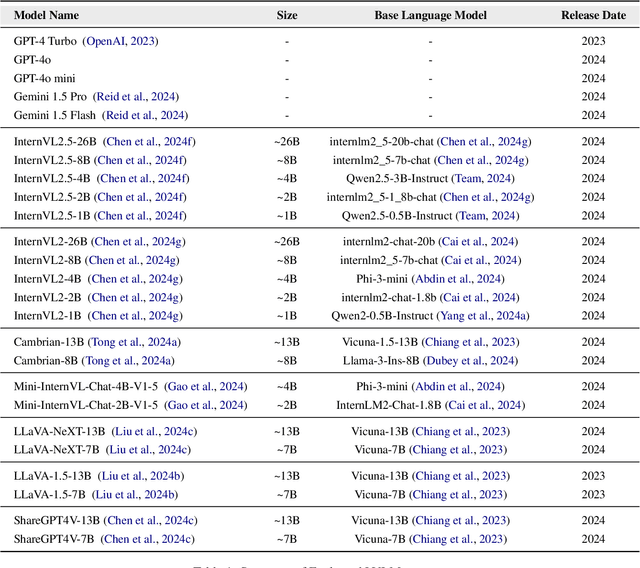
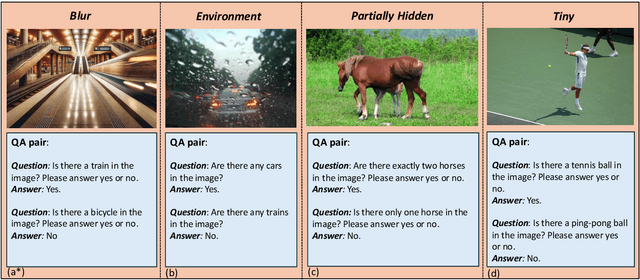
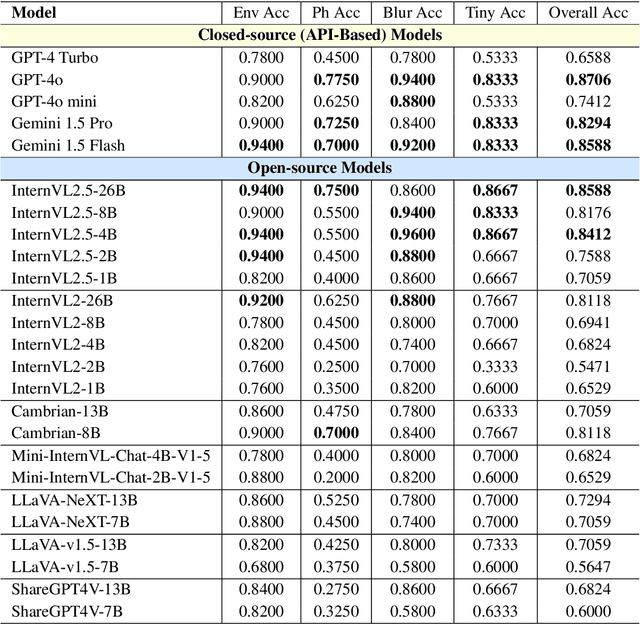
Abstract:Large Vision-Language Models (LVLMs) have shown impressive performance in various tasks. However, LVLMs suffer from hallucination, which hinders their adoption in the real world. Existing studies emphasized that the strong language priors of LVLMs can overpower visual information, causing hallucinations. However, the positive role of language priors is the key to a powerful LVLM. If the language priors are too weak, LVLMs will struggle to leverage rich parameter knowledge and instruction understanding abilities to complete tasks in challenging visual scenarios where visual information alone is insufficient. Therefore, we propose a benchmark called LanP to rethink the impact of Language Priors in LVLMs. It is designed to investigate how strong language priors are in current LVLMs. LanP consists of 170 images and 340 corresponding well-designed questions. Extensive experiments on 25 popular LVLMs reveal that many LVLMs' language priors are not strong enough to effectively aid question answering when objects are partially hidden. Many models, including GPT-4 Turbo, exhibit an accuracy below 0.5 in such a scenario.
Enhancing Sample Selection by Cutting Mislabeled Easy Examples
Feb 12, 2025Abstract:Sample selection is a prevalent approach in learning with noisy labels, aiming to identify confident samples for training. Although existing sample selection methods have achieved decent results by reducing the noise rate of the selected subset, they often overlook that not all mislabeled examples harm the model's performance equally. In this paper, we demonstrate that mislabeled examples correctly predicted by the model early in the training process are particularly harmful to model performance. We refer to these examples as Mislabeled Easy Examples (MEEs). To address this, we propose Early Cutting, which introduces a recalibration step that employs the model's later training state to re-select the confident subset identified early in training, thereby avoiding misleading confidence from early learning and effectively filtering out MEEs. Experiments on the CIFAR, WebVision, and full ImageNet-1k datasets demonstrate that our method effectively improves sample selection and model performance by reducing MEEs.
Early Stopping Against Label Noise Without Validation Data
Feb 11, 2025



Abstract:Early stopping methods in deep learning face the challenge of balancing the volume of training and validation data, especially in the presence of label noise. Concretely, sparing more data for validation from training data would limit the performance of the learned model, yet insufficient validation data could result in a sub-optimal selection of the desired model. In this paper, we propose a novel early stopping method called Label Wave, which does not require validation data for selecting the desired model in the presence of label noise. It works by tracking the changes in the model's predictions on the training set during the training process, aiming to halt training before the model unduly fits mislabeled data. This method is empirically supported by our observation that minimum fluctuations in predictions typically occur at the training epoch before the model excessively fits mislabeled data. Through extensive experiments, we show both the effectiveness of the Label Wave method across various settings and its capability to enhance the performance of existing methods for learning with noisy labels.
 Add to Chrome
Add to Chrome Add to Firefox
Add to Firefox Add to Edge
Add to Edge